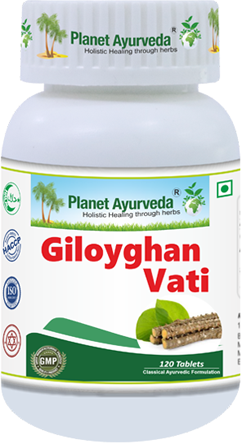Ayurvedic Alternative to Paracetamol (Acetaminophen) – Natural Pain & Fever Relief Herbs
Abstract
Fever is one of the most common physiological responses of the body to infection, inflammation, or illness. It is defined as a temporary rise in body temperature, typically above 37.5°C (99.5°F), as the immune system’s defense mechanism against invading pathogens such as bacteria, viruses, or toxins. Paracetamol is one of the most widely used antipyretic (reduces fever) and analgesics (relieves pain). It is the commonest drug used in fever, headache, migraine, musculoskeletal pain, dysmenorrhea, etc. However it should be used carefully as its overuse or overdose can lead to various life threatening complications. From ayurvedic perspective fever is not merely a rise of temperature but also an imbalance of doshas (trienergies) and formation of ama (toxins), thus focusing on the core problem. Now, let’s discuss Paracetamol, its uses and side effects and what are the possible ayurvedic alternatives of Paracetamol.
Introduction
Paracetamol is a para aminophenol derivative under the class of non-steroidal anti-inflammatory drugs (NSAIDS). It is an analgesic-antipyretic with poor anti-inflammatory action. The analgesic action of Paracetamol is like aspirin (it raises pain threshold) but it has weak peripheral anti-inflammatory components. Paracetamol is a rapidly acting antipyretic but it has a negligible anti-inflammatory action. Paracetamol is well absorbed orally and is distributed uniformly in the body. The effects after an oral dose lasts for 3-5 hours. Acetaminophen is another name for Paracetamol which is commonly used in the United States, Canada, and Japan. Tylenol is one of its most well-known brand names. Whereas in the United Kingdom, Australia, India it is known as paracetamol. Some of the brand names known here are Panadol, Calpol, Crocin.

Mode of Action
- Paracetamol exerts its antipyretic effect by acting primarily on the hypothalamic heat-regulating center in the brain.
- It acts primarily in the central nervous system (CNS). It inhibits the cyclooxygenase (COX) enzymes, particularly COX‑2 in the CNS and reduces the synthesis of prostaglandins (PGE₂) which are synthesized in the hypothalamus in response to pyrogenic cytokines like IL‑1, IL‑6, and TNF‑α and are chemical mediators responsible for pain and fever.
- The decreased PGE2 levels cause the hypothalamic set point to return to normal and the body dissipates excess heat by the vasodilation of the cutaneous blood vessels and increasing sweating.
Indications
- Fever
- Headache
- Joint pain
- Muscle pain
Contraindications
- Hypersensitivity or allergic cases
- Hepatic (liver) impairment
- Chronic alcoholism
- Renal (kidney) impairment
Adverse Effects
1. Nausea and vomiting
Rashes
2. Abdominal pain and tenderness
- Frequent use may suppress fever or pain, masking underlying infections or diseases.
- Hypoglycemia, jaundice, hepatic necrosis, renal tubular necrosis.
Ayurvedic Alternatives of ParacetamolL
Since people often rely on paracetamol for fever and pain relief, it frequently leads to the side effects and toxicity, so Ayurveda offers natural alternatives that are gentle on the body while effectively managing fever, inflammation, and pain. Herbs like Giloy (Tinospora cordifolia), Mustak (Cyperus rotundus), Sudarshan (Crinum latifolium), Chirayata (Swertia chirata), etc. are nature’s safest antipyretics, working in harmony with body physiology to promote lasting recovery and vitality.
Now let’s discuss about some in detail
1. Giloy
- Giloy or Tinospora cordifolia has Tikta (Bitter) and Kashaya (Astringent) Rasa (Taste) and Ushana Virya (Hot Potency) thus helps in pacifying all the three doshas. It consists of Giloin, Giloinin, Gilosterol, Berberine which exhibits anti-pyretic activity.
- In jeerna jwara (chronic fever) its decoction is specifically indicated.
2. Sudarshan
- Crinum latifolium or Sudarshan has Tikta (bitter) and Katu (pungent) Rasa (taste), Laghu (light) and Ruksha (dry) Guna (properties), and Ushna Virya (hot potency), which together help in digesting Ama (toxins), reducing Pitta-related heat, and restoring normal body temperature.
- It is especially useful in Visham Jwara (intermittent fever), Santata Jwara (continuous fever).
3. Chirayata
- Swertia chirayata or Chirayata has Kapha Pitta shamak (pacifying) properties. It has Jwaraghana (fever reducing) and Dahaprashamana (relieves from burning sensation) actions.
- Its decoction is specifically mentioned in the Jwara Chikitsa chapter of Charak Samhita.
4. Mustak
- Musta or Cyperus rotundus is a prominent herb to treat fever. Alkaloids like mustakone, Valerenic acid-like compounds are hepatoprotective and antipyretic. It is useful in fever associated with burning sensation and gastritis.
- मुस्तापर्पाटकं ज्वरे । (Astang Hridaya Sutrasthana)
- It means Musta and Parpataka are the best herbs to relieve fever.
5.Godanti
- It is an ayurvedic medicine prepared from gypsum. It has cold potency thus has specific action in fever with high body temperature and associated headache and excessive thirst.
- Its decoction along with Giloy (Tinospora cordifolia) is used in chronic fevers.
6.Sahadevi
- Vernonia cineria or sahadevi has tikta rasa (bitter taste) and thus helps in balancing pitta dosha and improving digestive fire. Its special effect is indicated in jwara (fever). It is swedajanana (induce sweating) thus helps in reducing fever.
- It has been mentioned in classical texts that tying its roots on the head helps to reduce fever.
7. Sariva
- Hemidesmus indicus has tridosha shamak (pacifying all three doshas) property. It has sheeta virya (cold potency) so helps in reducing fever and reduces burning and thirst associated with it. It also relieves post-febrile weakness and improves overall vitality.
Some of the formulations which include these herbs are
- Sudarshan Vati
- Tribhuvana Kirti Rasa
- Mruthyunjaya Rasa
- Amritarishta
- Giloy Ghan Vati
- Sudarshan Churna
- Anandbhairava Rasa
Planet Ayurveda’s Giloy Ghan Vati
Planet Ayurveda’s Giloy Ghan Vati is a tablet formulation which is made from pure organic Giloy extract with no additives. It is free from colour, chemicals, preservatives, starch and additives. Giloy being its main ingredient, offers a wide range of health benefits including antipyretic, anti-inflammatory, antioxidant, immune-boosting, and analgesic properties. Its active constituents like tinosporin, berberine, tinosporides, flavonoids etc. directly reduce elevated body temperature via modulation of pyrogenic mediators and by improving immune response, reducing excessive inflammation or regulating overactive cytokine release, fever can be moderated.
Its dosage is 1-2 tablets twice or thrice a day with lukewarm water.
Conclusion
Thus while paracetamol provides relief from fever and mild relief of the pain, however prolonged can lead to hepatic toxicity, gastric irritation, etc. In ayurveda however the principle of the treatment is to balance the trienergies (doshas) and detoxifying the whole system rather than just suppressing the symptoms. Ayurveda emphasizes holistic, preventive, and immune-strengthening approaches for long-term health.






